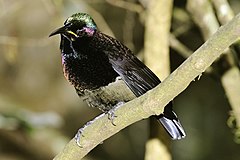Ptiloris
| Ptiloris[1] | |||
| Swainson, 1825[2] | |||
 Przedstawiciel rodzaju – samiec ozdobnika małego (P. victoriae) | |||
| Systematyka | |||
| Domena | |||
|---|---|---|---|
| Królestwo | |||
| Typ | |||
| Podtyp | |||
| Gromada | |||
| Podgromada | |||
| Infragromada | |||
| Rząd | |||
| Podrząd | |||
| Rodzina | |||
| Rodzaj |
Ptiloris | ||
| Typ nomenklatoryczny | |||
|
Ptiloris paradiseus Swainson, 1825 | |||
| Synonimy | |||
|
| |||
| Gatunki | |||
| |||
Ptiloris – rodzaj ptaków z rodziny cudowronek (Paradisaeidae).
Zasięg występowania[edytuj | edytuj kod]
Rodzaj obejmuje gatunki występujące na Nowej Gwinei i w Australii[11].
Morfologia[edytuj | edytuj kod]
Długość ciała samców 25–34 cm, masa ciała samców 91–230 g; długość ciała samic 23–29 cm, masa ciała samic 77–185 g[12].
Systematyka[edytuj | edytuj kod]
Rodzaj zdefiniował w 1825 roku brytyjski zoolog William Swainson na łamach The Zoological Journal[2]. Gatunkiem typowym jest ozdobnik rajski (Ptiloris paradiseus).
Etymologia[edytuj | edytuj kod]
- Ptiloris (Ptilorhis, Ptilorhys, Ptilorbis, Ptilornis): gr. πτιλον ptilon „pióro”; ῥις rhis, ῥινος rhinos „nozdrza”[13].
- Craspedophora: gr. κρασπεδον kraspedon „frędzel, kutas”; -φορος -phoros „noszący”, od φερω pherō „nosić”[14]. Typ nomenklatoryczny: Falcinellus magnificus Vieillot, 1819.
- Mathewsiella: Gregory Macalister Mathews (1876–1949), australijski ornitolog, kolekcjoner; łac. przyrostek zdrabniający -ella[15].
- Pherocraspedon: gr. φερω pherō „nosić”; κρασπεδον kraspedon „frędzel, kutas”[16].
Podział systematyczny[edytuj | edytuj kod]
Do rodzaju należą następujące gatunki[17]:
- Ptiloris paradiseus Swainson, 1825 – ozdobnik rajski
- Ptiloris victoriae Gould, 1850 – ozdobnik mały
- Ptiloris magnificus (Vieillot, 1819) – ozdobnik wspaniały
- Ptiloris intercedens Sharpe, 1882 – ozdobnik tarczowy
Uwagi[edytuj | edytuj kod]
- ↑ a b c d e Niepoprawna późniejsza pisownia Ptiloris Swainson, 1825.
- ↑ Nowa nazwa dla Craspedophora G.R. Gray, 1840 gdyż Iredale uważał że jest młodszym homonimem Craspedophorus Hope, 1838 (Coleoptera).
- ↑ Nowa nazwa dla Mathewsiella Iredale, 1922 gdyż Mathews uważał że jest młodszym homonimem Matthewsiella Hetschko, 1913 (Coleoptera).
Przypisy[edytuj | edytuj kod]
- ↑ Ptiloris, [w:] Integrated Taxonomic Information System (ang.).
- ↑ a b W. Swainson. On the Characters and Natural Affinities of several New Birds from Australasia; including some Obserwations on the Columbidae. „The Zoological Journal”. 1 (4), s. 479, 1825. (ang.).
- ↑ G.R. Gray: A list of the genera of birds: with their synonyma an indication of the typical species of each genus. London: R. and J.E. Taylor, 1840, s. 1 (Addenda at errata). (ang.).
- ↑ J. Cabanis: Museum Heineanum: Verzeichniss der ornithologischen Sammlung des Oberamtmann Ferdinand Heine, auf Gut St. Burchard vor Halberstadt. T. 1: Singvögel. Halberstadt: In Commission bei R. Frantz, 1850–1851. (niem.).
- ↑ Ch.L. Bonaparte. Conspectus systematis ornithologiæ. „Annales des Sciences Naturelles, Zoologie”. Quatrième série. 1 (2), s. 122, 1854. (fr.).
- ↑ L.J.F.J. Fitzinger: Über das System und die Charakteristik der natürlichen Familien der Vögel. Wien: Kais. Kön. Hof- und Staatsdruckerei, 1856, s. 227. (niem.).
- ↑ G.R. Gray: Hand-list of genera and species of birds, distinguishing those contained in the British Museum. Cz. 1. London: printed by order of the Trustees, 1869, s. 104. (ang.).
- ↑ T. Salvadori: Ornitologia della Papuasia e delle Molucche. Cz. 2. Torino: Stamperia reale G.B. Paravia e co. di I. Vigliardi, 1881, s. 559. (wł.).
- ↑ T. Iredale. Proposed the new generic name of Mathewsiella for Craspedophora magnified claudia Mathews. „Bulletin of the British Ornithologists’ Club”. 43 (272), s. 39, 1922. (ang.).
- ↑ G.M. Mathews. Forwarded the description of a new subspecies, Quoyornis leucurus mimika; a note that Pœcilodryas cinerea should be called Quoyornis leucurus cinereus; also names of new genera: Coleia should be Colena and Matthewsiella, Pherocraspedon. „Bulletin of the British Ornithologists’ Club”. 52 (353), s. 25, 1931. (ang.).
- ↑ F. Gill, D. Donsker & P. Rassmusen (redaktorzy): Crows, mudnesters & birds-of-paradise. IOC World Bird List: Version 13.1. [dostęp 2023-05-21]. (ang.).
- ↑ D.W. Winkler, S.M. Billerman & I.J. Lovette: Birds-of-Paradise (Paradisaeidae), version 1.0. W: S.M. Billerman, B.K. Keeney, P.G. Rodewald & T.S. Schulenberg (redaktorzy): Birds of the World. Ithaca, NY: Cornell Lab of Ornithology, 2020. DOI: 10.2173/bow.paradi7.01. [dostęp 2023-05-21]. (ang.).

- ↑ The Key to Scientific Names ↓, Ptiloris [dostęp 2023-05-21].
- ↑ The Key to Scientific Names ↓, Craspedophora [dostęp 2023-05-21].
- ↑ The Key to Scientific Names ↓, Mathewsiella [dostęp 2023-05-21].
- ↑ The Key to Scientific Names ↓, Pherocraspedon [dostęp 2023-05-21].
- ↑ Systematyka i nazwy polskie za: P. Mielczarek & M. Kuziemko: Rodzina: Paradisaeidae Vigors, 1825 - cudowronki - Birds of paradise (wersja: 2022-09-03). [w:] Kompletna lista ptaków świata [on-line]. Instytut Nauk o Środowisku Uniwersytetu Jagiellońskiego. [dostęp 2023-05-21].
Bibliografia[edytuj | edytuj kod]
- The Key to Scientific Names, J.A. Jobling (red.), [w:] Birds of the World, S.M. Billerman et al. (red.), Cornell Lab of Ornithology, Ithaca (ang.).
